2012-12-21. Mayan Oxlajuj Baktun: End of an Era, More of the Same.
Zaculeu. Huehuetenango, Guatemala.
December 20-21, 2012.
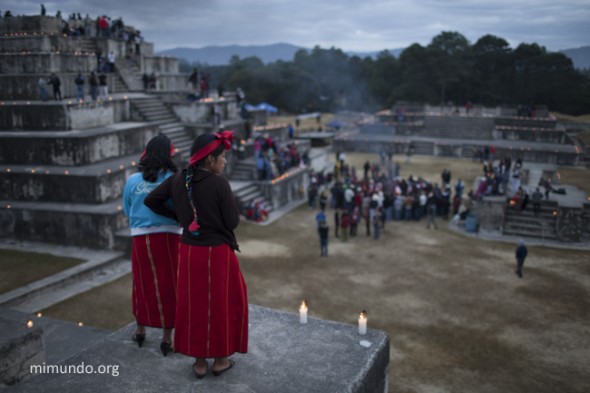 Events in the Guatemalan northern city of Huehuetenango during the much-awaited end of the Mayan Oxlajuj Baktun provide a clear reflection of the divisions and challenges faced by Mayan communities today. The media exploited erroneous apocalyptic rumors, the government and business sectors viewed it as an opportunity to gain economically through tourism, and progressive groups seized the opportunity “to strengthen ancestral wisdom and never-ending search for balance” while vindicating what seem never-ending struggles for justice, inclusion, and self-determination. (1)
Events in the Guatemalan northern city of Huehuetenango during the much-awaited end of the Mayan Oxlajuj Baktun provide a clear reflection of the divisions and challenges faced by Mayan communities today. The media exploited erroneous apocalyptic rumors, the government and business sectors viewed it as an opportunity to gain economically through tourism, and progressive groups seized the opportunity “to strengthen ancestral wisdom and never-ending search for balance” while vindicating what seem never-ending struggles for justice, inclusion, and self-determination. (1)
December 20, 2012:
 16:45. Official government-sponsored activities began on December 20th in Huehuetenango’s central park. Here, María Mercedes Escobar, 2012 Departmental Queen of Huehuetenango, dances during an event called “Mayan Queens”. According to a United Nations Development Program report from 2011, Huehuetenango has an indigenous Mayan population of 64%, equivalent to 725,000 people, from which 85% live in poverty or extreme poverty. (2)
16:45. Official government-sponsored activities began on December 20th in Huehuetenango’s central park. Here, María Mercedes Escobar, 2012 Departmental Queen of Huehuetenango, dances during an event called “Mayan Queens”. According to a United Nations Development Program report from 2011, Huehuetenango has an indigenous Mayan population of 64%, equivalent to 725,000 people, from which 85% live in poverty or extreme poverty. (2)
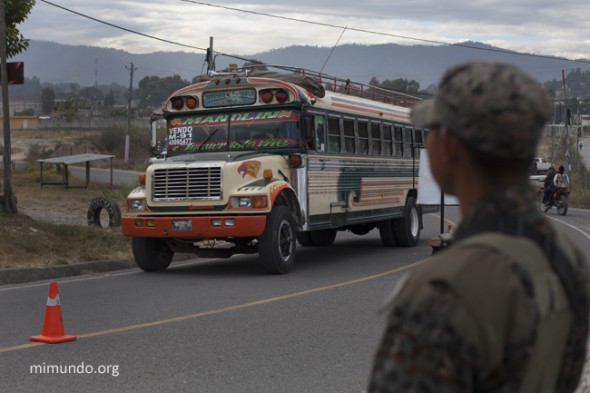 Soldiers from the 5th Infantry Brigade, stationed in Mariscal Gregorio Solares base, Huehuetenango, place checkpoints outside the ancient Mayan site of Zaculeu.
Soldiers from the 5th Infantry Brigade, stationed in Mariscal Gregorio Solares base, Huehuetenango, place checkpoints outside the ancient Mayan site of Zaculeu.
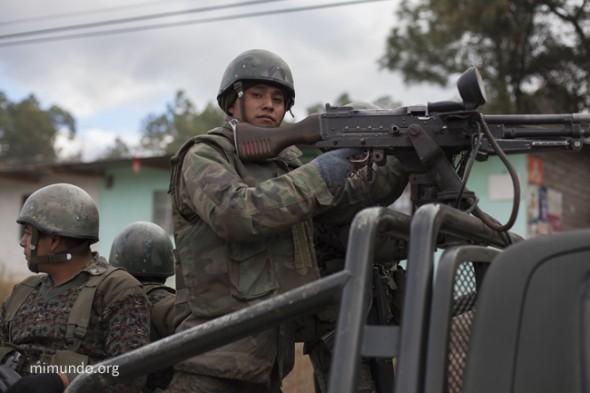 The population of Huehuetenango suffered brutal violence during the 36-year Internal Armed Conflict (1960-1996) as numerous massacres were carried out against the civilian population, mostly by the Armed Forces. While the 1996 Peace Accords prohibit the Guatemalan State from using its Armed Forces for internal security issues, three successive governments have continually violated this pact by having Army personnel patrol the streets.
The population of Huehuetenango suffered brutal violence during the 36-year Internal Armed Conflict (1960-1996) as numerous massacres were carried out against the civilian population, mostly by the Armed Forces. While the 1996 Peace Accords prohibit the Guatemalan State from using its Armed Forces for internal security issues, three successive governments have continually violated this pact by having Army personnel patrol the streets.
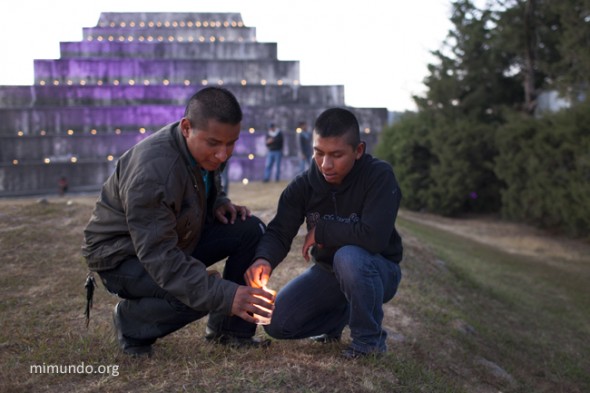 17:51. Wilson Romero Tojín De León (left), 20, and Gaspar Hernández Mendoza, 18, both soldiers in the 5th Infantry Brigade, light up candles previous to the Oxlajuj Baktun celebrations in the ancient Mayan city of Zaculeu. Hundreds of soldiers in plain clothes served as security personnel throughout the event.
17:51. Wilson Romero Tojín De León (left), 20, and Gaspar Hernández Mendoza, 18, both soldiers in the 5th Infantry Brigade, light up candles previous to the Oxlajuj Baktun celebrations in the ancient Mayan city of Zaculeu. Hundreds of soldiers in plain clothes served as security personnel throughout the event.
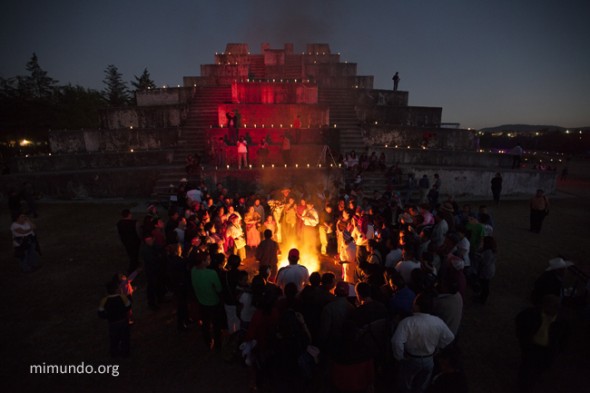 18:08. A Mayan spiritual ceremony takes place in Zaculeu’s main plaza on the eve before the end of the Oxlajuj (or 13) Baktun Era. According to the long Mayan Calendar, 13 Baktun consists of 5,129 years.
18:08. A Mayan spiritual ceremony takes place in Zaculeu’s main plaza on the eve before the end of the Oxlajuj (or 13) Baktun Era. According to the long Mayan Calendar, 13 Baktun consists of 5,129 years.
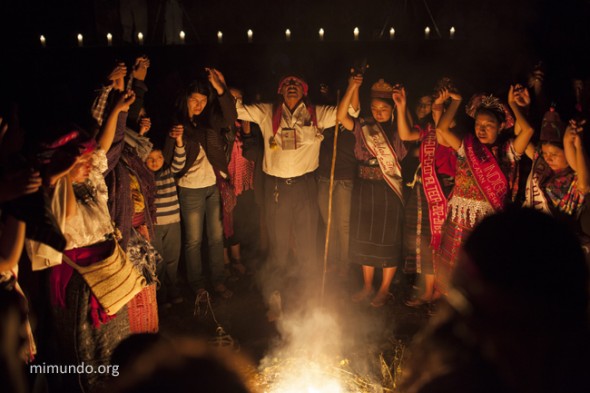 Agustín García López (middle), Ajq’ij, or Mayan Spiritual Guide, from San Sebastian Huehuetenango, leads celebrations in the ancient Mayan site of Zaculeu. Agustín states: “I was selected by our ancestors through my dreams so that I could ask our mother earth and father sun for the wellbeing of our community. I am here to thank the Sun for having shone on us the past 5200 years, and to welcome him in these next 5200 years to come.”
Agustín García López (middle), Ajq’ij, or Mayan Spiritual Guide, from San Sebastian Huehuetenango, leads celebrations in the ancient Mayan site of Zaculeu. Agustín states: “I was selected by our ancestors through my dreams so that I could ask our mother earth and father sun for the wellbeing of our community. I am here to thank the Sun for having shone on us the past 5200 years, and to welcome him in these next 5200 years to come.”
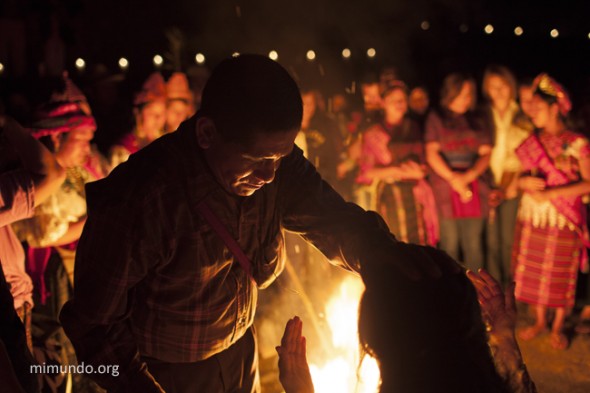 Santiago Ordoñez, Ajq’ij from San Idelfonso Ixtahuacán, carries out an act of blessing or healing during the ceremony.
Santiago Ordoñez, Ajq’ij from San Idelfonso Ixtahuacán, carries out an act of blessing or healing during the ceremony.
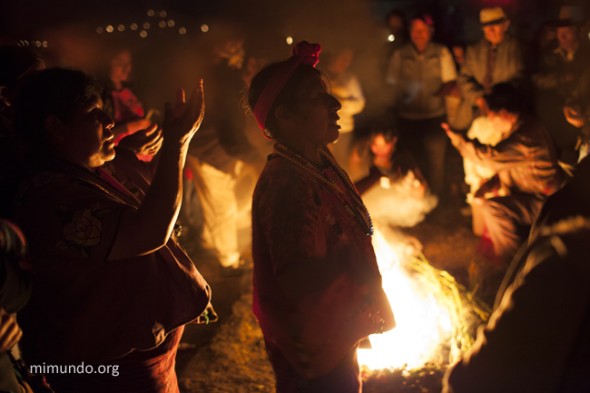 María Pérez Domingo, Ajq’ij from San Idelfonso Ixtahuacán affiliated to Oxlajuj Ajpop, prays to the four cardinal points.
María Pérez Domingo, Ajq’ij from San Idelfonso Ixtahuacán affiliated to Oxlajuj Ajpop, prays to the four cardinal points.
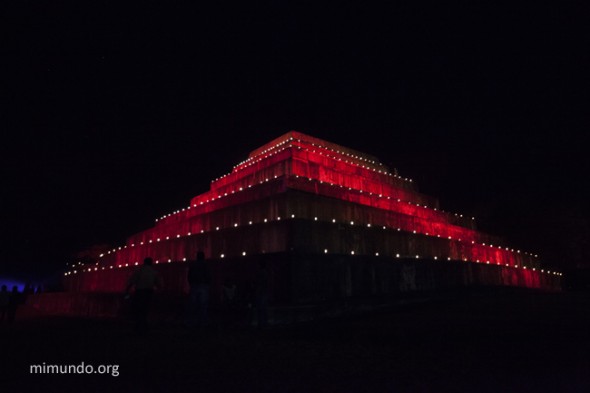 5,200 candles were placed on the temples of Zaculeu, each representing a year of the Baktun cycle.
5,200 candles were placed on the temples of Zaculeu, each representing a year of the Baktun cycle.
December 21, 2012:
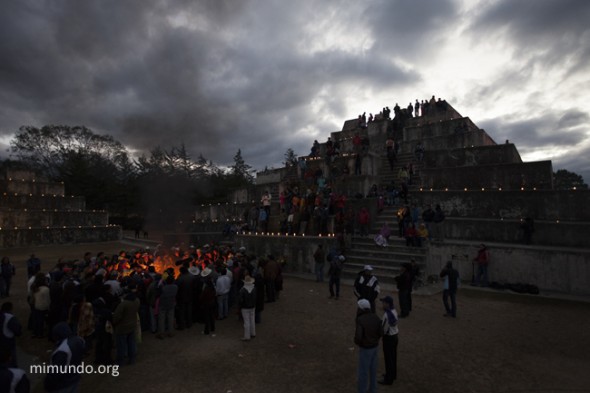 6:11. A Mayan spiritual ceremony takes place in Zaculeu’s main plaza to welcome the Sunrise on the last day of the Oxlajuj Baktun.
6:11. A Mayan spiritual ceremony takes place in Zaculeu’s main plaza to welcome the Sunrise on the last day of the Oxlajuj Baktun.
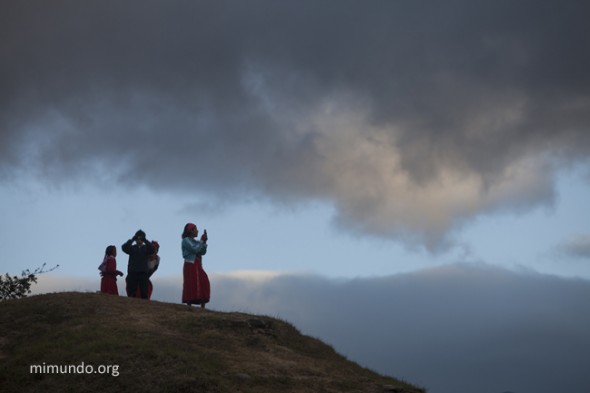 6:46. Anselma Robledo Bravos, 16, Tectitec Mayan, takes a photograph of the events in the Main Plaza with her cell phone from the top of Structure 9.
6:46. Anselma Robledo Bravos, 16, Tectitec Mayan, takes a photograph of the events in the Main Plaza with her cell phone from the top of Structure 9.
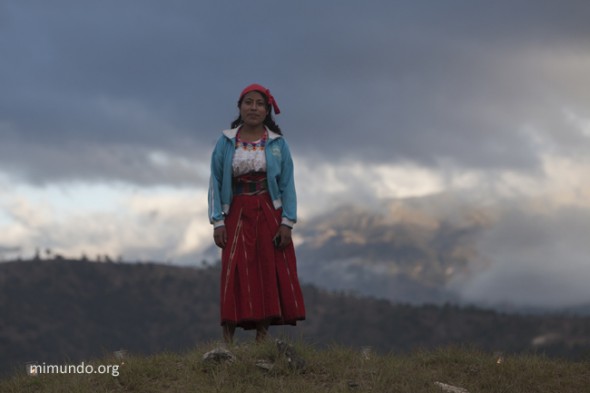 Anselma states: “I think it was the foreigners who invented this whole end-of-the-world scenario so they could make movies and profit from it.”
Anselma states: “I think it was the foreigners who invented this whole end-of-the-world scenario so they could make movies and profit from it.”
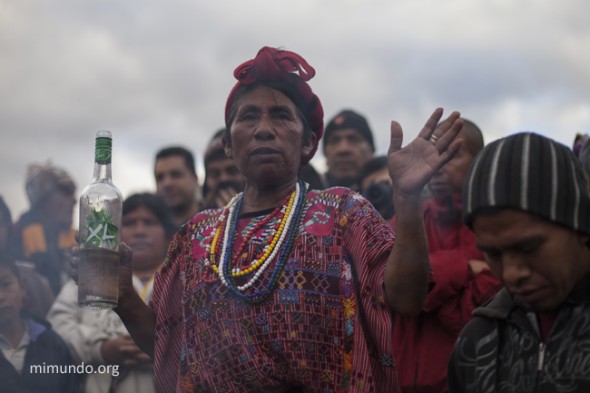 7:22. María Pérez Domingo, Ajq’ij from San Idelfonso Ixtahuacán affiliated to Oxlajuj Ajpop, carries out healing and blessing sessions during the ceremony. “I guess God wanted me to drink a lot today” she states, since part of her sessions involve the drinking and spitting of liquor.
7:22. María Pérez Domingo, Ajq’ij from San Idelfonso Ixtahuacán affiliated to Oxlajuj Ajpop, carries out healing and blessing sessions during the ceremony. “I guess God wanted me to drink a lot today” she states, since part of her sessions involve the drinking and spitting of liquor.
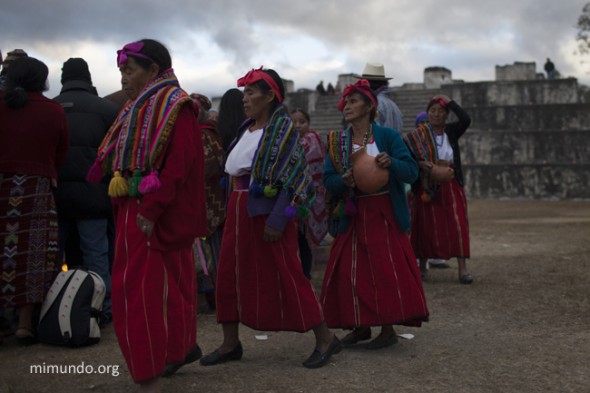 Tectitec Mayan women hired by the Ministry of Public Health, official organizer of the event in Zaculeu, dance around a bonfire that serves as the center of the Mayan spiritual ceremony.
Tectitec Mayan women hired by the Ministry of Public Health, official organizer of the event in Zaculeu, dance around a bonfire that serves as the center of the Mayan spiritual ceremony.
 Alberto Eugenio Hernández, Ajq’ij from Tectitán hired by the Ministry of Health, prays during the ceremony. Mr. Hernández holds the unique distinction of using an FC Barcelona soccer team scarf as a head wrap and praying utensil.
Alberto Eugenio Hernández, Ajq’ij from Tectitán hired by the Ministry of Health, prays during the ceremony. Mr. Hernández holds the unique distinction of using an FC Barcelona soccer team scarf as a head wrap and praying utensil.
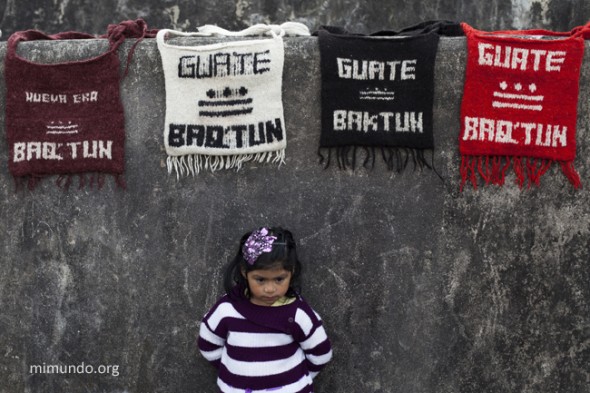 A girl stands in front of hand-woven morrales, or satchels, for sale that read “Guate 13 Baktun”. The two lines with three dots above represent the number 13 as written in ancient Mayan scripture.
A girl stands in front of hand-woven morrales, or satchels, for sale that read “Guate 13 Baktun”. The two lines with three dots above represent the number 13 as written in ancient Mayan scripture.
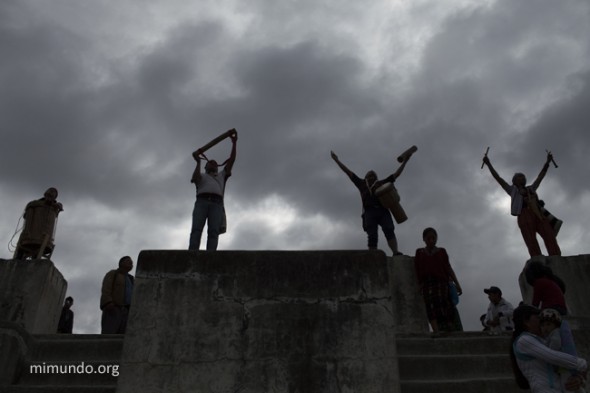 9:33. A group called the “Mayas Latinos” spent several hours on top of Structure 1, the tallest in Zaculeu, performing numerous musical acts using instruments associated with Mesoamerica indigenous cultures, such as the rain stick and unique percussion instruments.
9:33. A group called the “Mayas Latinos” spent several hours on top of Structure 1, the tallest in Zaculeu, performing numerous musical acts using instruments associated with Mesoamerica indigenous cultures, such as the rain stick and unique percussion instruments.
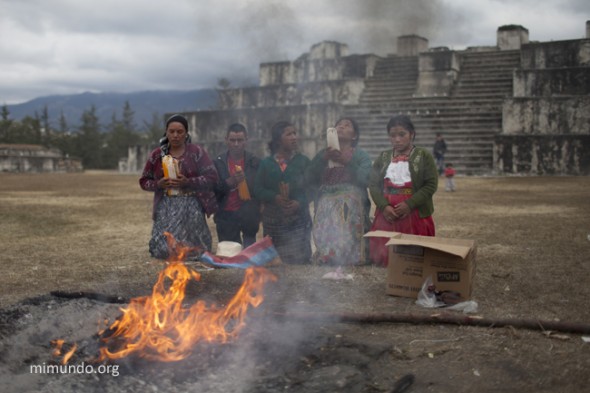 9:35. An unaffiliated group performs an intimate Mayan ceremony in the Main Plaza during a break in the official event schedule.
9:35. An unaffiliated group performs an intimate Mayan ceremony in the Main Plaza during a break in the official event schedule.
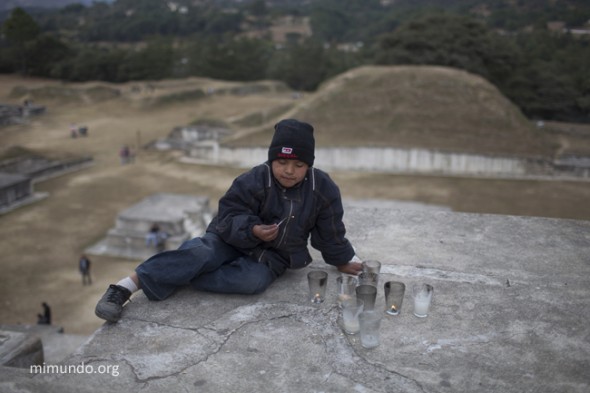 A boy plays with candles atop Structure 1.
A boy plays with candles atop Structure 1.
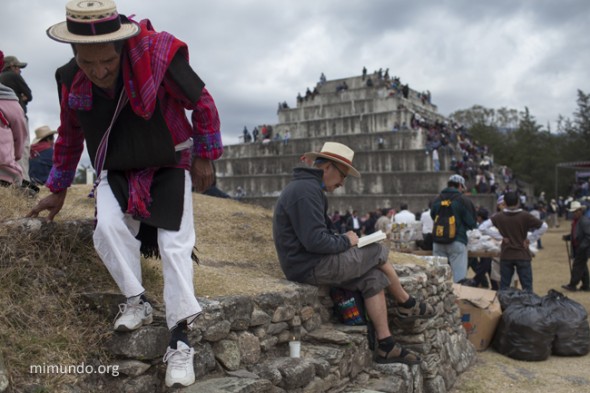 An indigenous man from San Juan Atitán descends a structure while a foreign tourist reads.
An indigenous man from San Juan Atitán descends a structure while a foreign tourist reads.
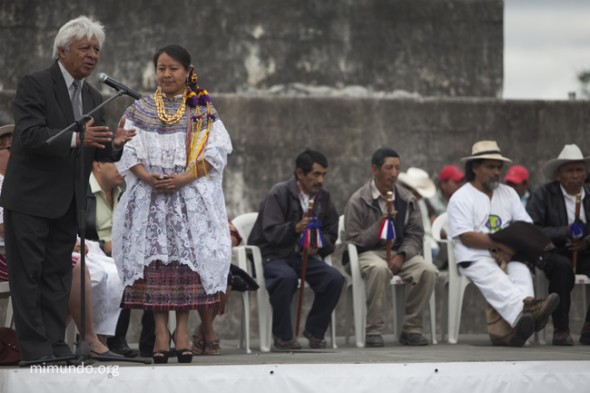 10:52. A representative of the Ministry of Public Health, governmental institution that organized the official celebration in the ancient Mayan site of Zaculeu, introduces Mayan spiritual leaders who accepted to participate in the State-sponsored event.
10:52. A representative of the Ministry of Public Health, governmental institution that organized the official celebration in the ancient Mayan site of Zaculeu, introduces Mayan spiritual leaders who accepted to participate in the State-sponsored event.
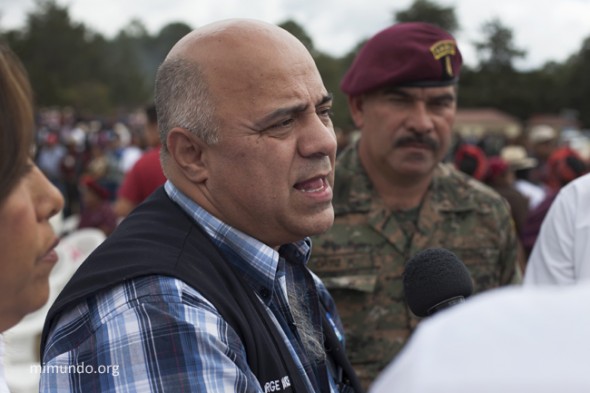 Jorge Villavicencio, Minister of Public Health, gives an interview while an Armed Forces special unit member known as a Kaibil watches in the background. “This is an important event, a chance to let the world know of the natural and cultural riches found in Guatemala,” states the minister.
Jorge Villavicencio, Minister of Public Health, gives an interview while an Armed Forces special unit member known as a Kaibil watches in the background. “This is an important event, a chance to let the world know of the natural and cultural riches found in Guatemala,” states the minister.
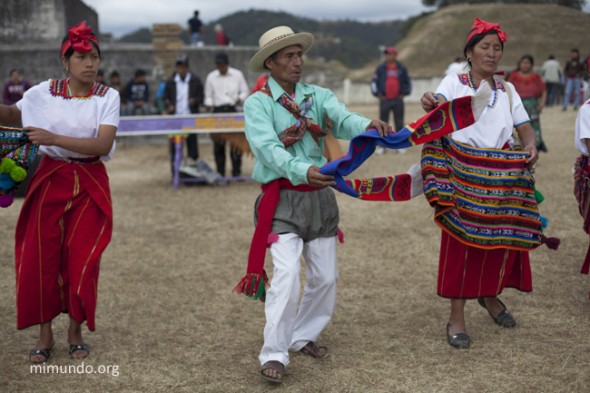 Alberto Eugenio Hernández (center), Ajq’ij from Tectitán, leads a dance during the government-sponsored celebrations in the ancient Mayan site of Zaculeu. Mr. Hernández, who also held Mayan Ceremonies throughout the day, uses an FC Barcelona soccer team scarf as a head wrap during ceremonies and as a dance prop during his performances.
Alberto Eugenio Hernández (center), Ajq’ij from Tectitán, leads a dance during the government-sponsored celebrations in the ancient Mayan site of Zaculeu. Mr. Hernández, who also held Mayan Ceremonies throughout the day, uses an FC Barcelona soccer team scarf as a head wrap during ceremonies and as a dance prop during his performances.
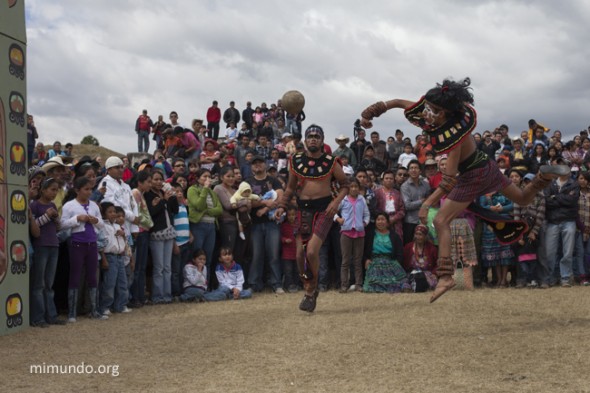 Performers hired by the Ministry of Culture participate in an event recreating the Mayan ball game during the official celebrations at Zaculeu.
Performers hired by the Ministry of Culture participate in an event recreating the Mayan ball game during the official celebrations at Zaculeu.
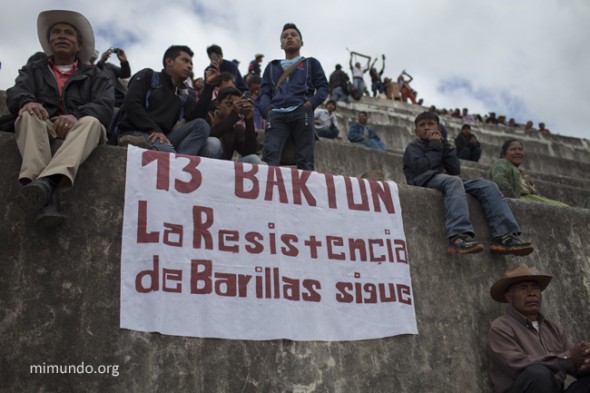 9:26. People sit on top of Structure 1 with a banner that reads: “13 Baktun, the resistance continues in Barillas” as they await the start of a Western Mayan People’s Council (Consejo de los Pueblos Maya del Occidente – CPO -, in Spanish) event in Zaculeu. The CPO, which held a political event to counter the official State-run celebrations, declared during a communiqué read out loud: “It is offensive for the Maya people to see the economic power and government institutions promote the folklorization (sic) of Oxlajuj B’ak’tun, commercializing this important event, creating a political image out of tourist promotion and the presentation of spectacles, in a way that does not appropriately interpret the Mayan view of the world.” (3)
9:26. People sit on top of Structure 1 with a banner that reads: “13 Baktun, the resistance continues in Barillas” as they await the start of a Western Mayan People’s Council (Consejo de los Pueblos Maya del Occidente – CPO -, in Spanish) event in Zaculeu. The CPO, which held a political event to counter the official State-run celebrations, declared during a communiqué read out loud: “It is offensive for the Maya people to see the economic power and government institutions promote the folklorization (sic) of Oxlajuj B’ak’tun, commercializing this important event, creating a political image out of tourist promotion and the presentation of spectacles, in a way that does not appropriately interpret the Mayan view of the world.” (3)
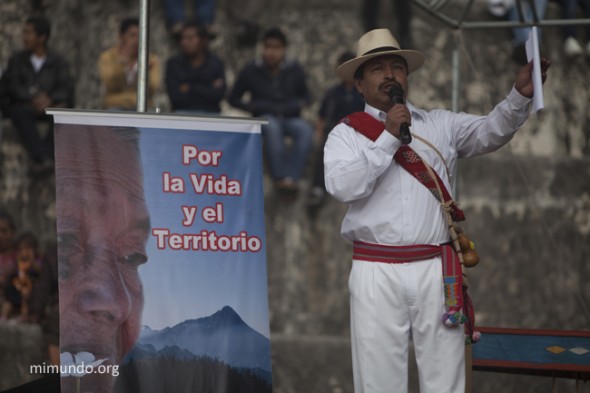 Aniceto Morales, from Colotenango, acts as master of ceremonies during the CPO’s event. The communiqué also declares: “It is shameful on the part of the Guatemalan government to make the international community believe it is promoting the Mayan culture, when it continues to develop an aggressive policy of appropriation of our natural resources. This manifests itself in hundreds of concessions and imposed mining projects, hydroelectric dams, oil extraction, monoculture crops for transnational companies, all in the name of false development as a method of domination and racism in Guatemala.” (4)
Aniceto Morales, from Colotenango, acts as master of ceremonies during the CPO’s event. The communiqué also declares: “It is shameful on the part of the Guatemalan government to make the international community believe it is promoting the Mayan culture, when it continues to develop an aggressive policy of appropriation of our natural resources. This manifests itself in hundreds of concessions and imposed mining projects, hydroelectric dams, oil extraction, monoculture crops for transnational companies, all in the name of false development as a method of domination and racism in Guatemala.” (4)
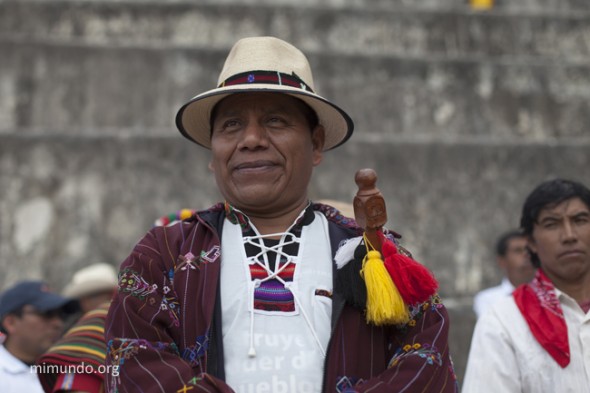 Victor Manuel Sales Ortíz, formerly known as Commander José Luis of the Poor People’s Army (EGP), former congressman for the Guatemalan National Revolutionary Unit (URNG) from 2003 to 2007, current president of the Mam People’s Council Saqtx’otx’ Chinab’jul and board member of the CPO, prepares to speak at the event.
Victor Manuel Sales Ortíz, formerly known as Commander José Luis of the Poor People’s Army (EGP), former congressman for the Guatemalan National Revolutionary Unit (URNG) from 2003 to 2007, current president of the Mam People’s Council Saqtx’otx’ Chinab’jul and board member of the CPO, prepares to speak at the event.
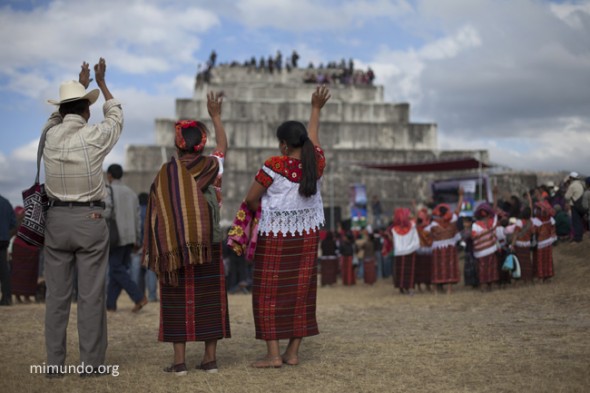 “In exercising of our collective rights as regulated by the ILO Convention 169 and the Declaration by the United Nations on the Rights of the Indigenous Peoples, the response of the state has been the criminalization of social struggles and repression against our communities and leaders,” states the CPO’s communiqué. (5)
“In exercising of our collective rights as regulated by the ILO Convention 169 and the Declaration by the United Nations on the Rights of the Indigenous Peoples, the response of the state has been the criminalization of social struggles and repression against our communities and leaders,” states the CPO’s communiqué. (5)
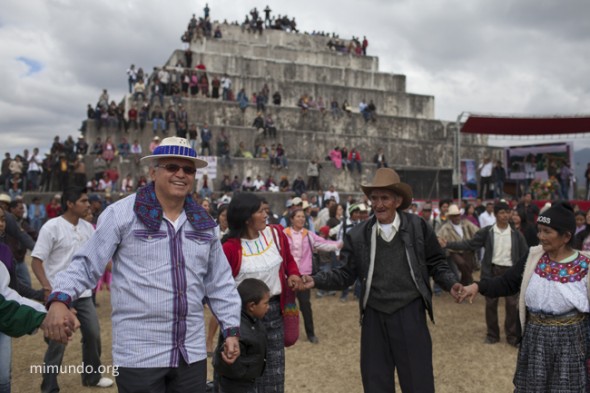 Monsignor Alvaro Ramazzini, dressed in a traditional Todos Santos Cuchumatán outfit (left), dances during the CPO’s alternative event. Monsignor Ramazzini, well-know advocate of self-determination by Guatemala’s indigenous communities and Bishop of Huehuetenango since July 2012, declares: “I am sad to see that the government is holding a simultaneous event just a few meters from us. It is sad because what the country really needs is a radical democracy, one where the people can choose freely without any manipulations. This country continues to be run by a small minority who ignores the needs of the majority, mostly indigenous peasants.”
Monsignor Alvaro Ramazzini, dressed in a traditional Todos Santos Cuchumatán outfit (left), dances during the CPO’s alternative event. Monsignor Ramazzini, well-know advocate of self-determination by Guatemala’s indigenous communities and Bishop of Huehuetenango since July 2012, declares: “I am sad to see that the government is holding a simultaneous event just a few meters from us. It is sad because what the country really needs is a radical democracy, one where the people can choose freely without any manipulations. This country continues to be run by a small minority who ignores the needs of the majority, mostly indigenous peasants.”
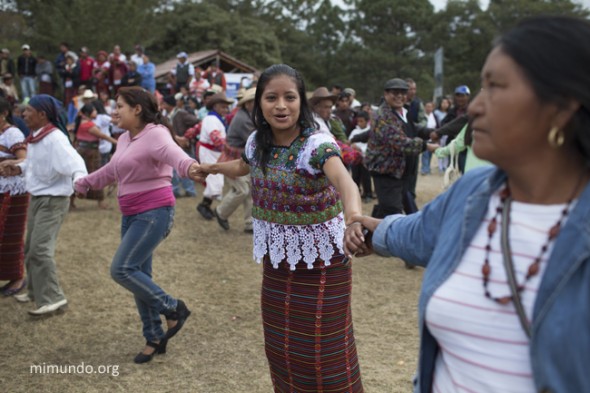 Hundreds gather to dance in unison as they form a spiral.
Hundreds gather to dance in unison as they form a spiral.
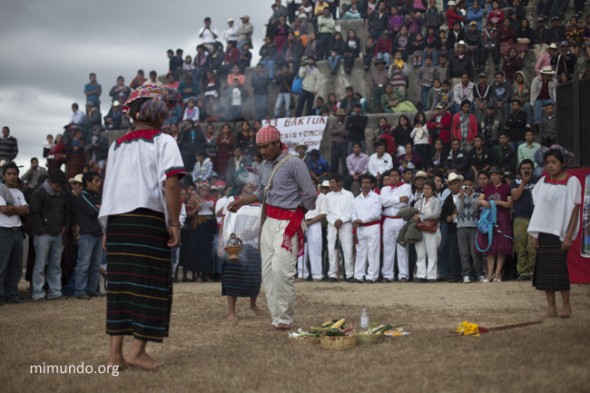 The CPO communiqué continues: “The attacks against our communities include May 1st in Santa Cruz Barillas and the Totonicapán massacre of October 4th, which force us to continue our process of reforming and strengthening our own authorities and institutions. We will continue to promote the correct application of the norms and principals regulated by the ILO Convention 169 and the Declaration by the United Nations on the Rights of the Indigenous Peoples. At the start of this new era, native peoples should move from submission to effective participation as historic political actors.” (6)
The CPO communiqué continues: “The attacks against our communities include May 1st in Santa Cruz Barillas and the Totonicapán massacre of October 4th, which force us to continue our process of reforming and strengthening our own authorities and institutions. We will continue to promote the correct application of the norms and principals regulated by the ILO Convention 169 and the Declaration by the United Nations on the Rights of the Indigenous Peoples. At the start of this new era, native peoples should move from submission to effective participation as historic political actors.” (6)
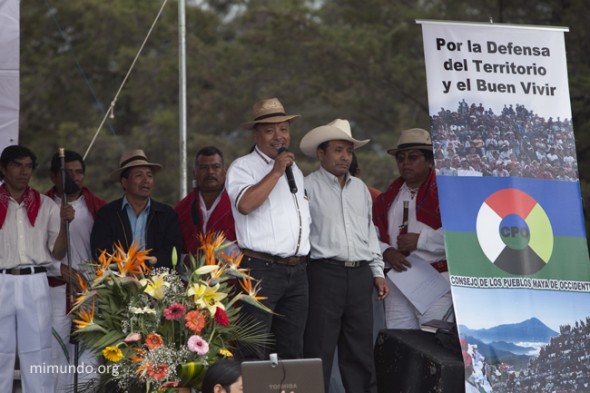 Eliub Orozco (with microphone), from San Marcos, introduces Pablo Antonio Pablo from Santa Cruz Barillas. On May 1st, Pablo suffered serious injuries from an armed attack carried out by private security forces from the Santa Cruz Hydroelectric project in Barillas. A long-running dispute due to the development of Spanish-run Hydro Santa Cruz despite a community consultation, or plebiscite, that rejected the development of such projects, triggered a violent conflict this year that has led to numerous deaths, a state of siege, permanent militarization and political persecution in the area.
Eliub Orozco (with microphone), from San Marcos, introduces Pablo Antonio Pablo from Santa Cruz Barillas. On May 1st, Pablo suffered serious injuries from an armed attack carried out by private security forces from the Santa Cruz Hydroelectric project in Barillas. A long-running dispute due to the development of Spanish-run Hydro Santa Cruz despite a community consultation, or plebiscite, that rejected the development of such projects, triggered a violent conflict this year that has led to numerous deaths, a state of siege, permanent militarization and political persecution in the area.
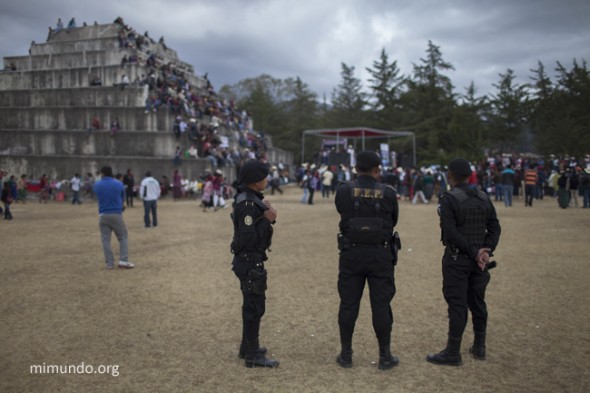 11:21. National Civil Police officers look on to the CPO’s political event as the communiqué concludes: “The Presidential reform to the Constitution of the Republic and reforms to the mining law and laws governing teacher education, are initiatives by the government that do not favor our communities. Instead, they represent setbacks to the victories of social struggles because they are meant to consolidate the economic model of accumulation based on agro-business; mining, oil, and hydroelectric exploitation and the privatization of public services, only benefiting a limited number of families who have historically exploited and repressed our communities.” (7)
11:21. National Civil Police officers look on to the CPO’s political event as the communiqué concludes: “The Presidential reform to the Constitution of the Republic and reforms to the mining law and laws governing teacher education, are initiatives by the government that do not favor our communities. Instead, they represent setbacks to the victories of social struggles because they are meant to consolidate the economic model of accumulation based on agro-business; mining, oil, and hydroelectric exploitation and the privatization of public services, only benefiting a limited number of families who have historically exploited and repressed our communities.” (7)
To license images individually, click here.
Version en español aquí.
1 Consejo de Pueblos Maya de Occidente (CPO). “Posicionamiento Político en el Marco del Oxlajuj B’ak’tun”. Nov. 30, 2012.
2 Programa de las Naciones Unidas para el Desarrollo (PNUD). Cifras para el desarrollo humano: Huehuetenango. Guatemala, 2011.
3 Op. Cit. CPO
4 Ibid.
5 Ibid.
6 Ibid.
7 Ibid.

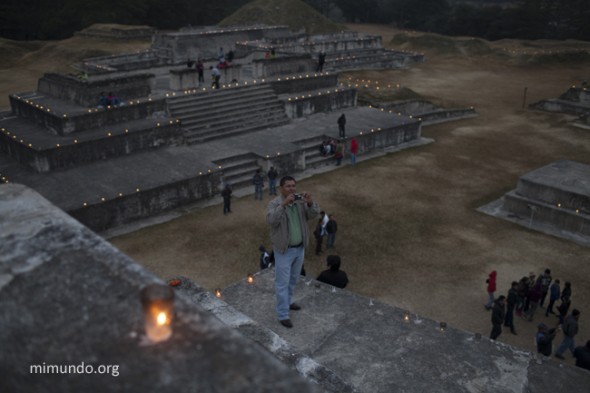
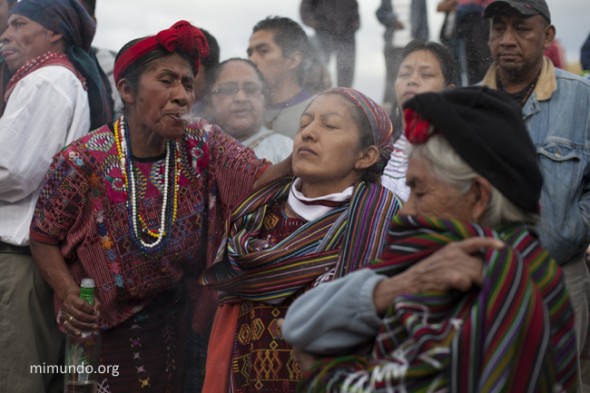

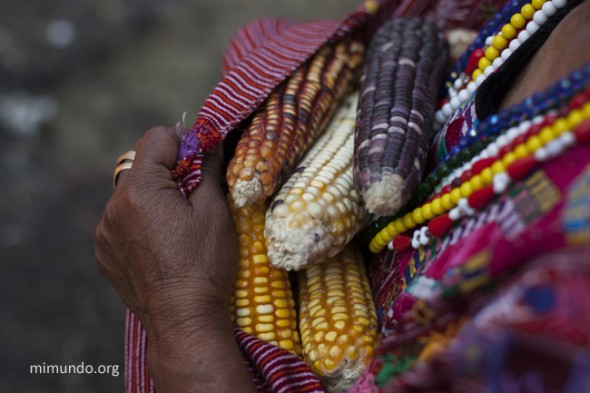
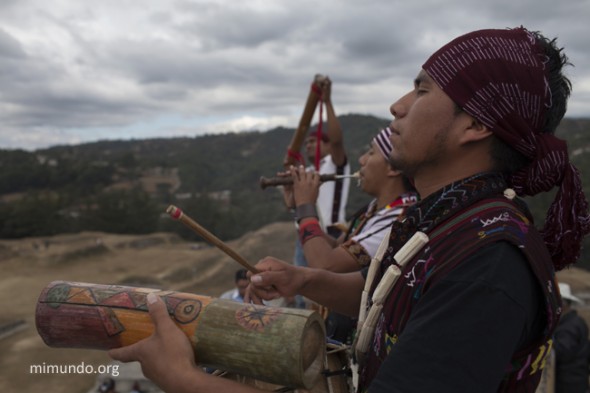
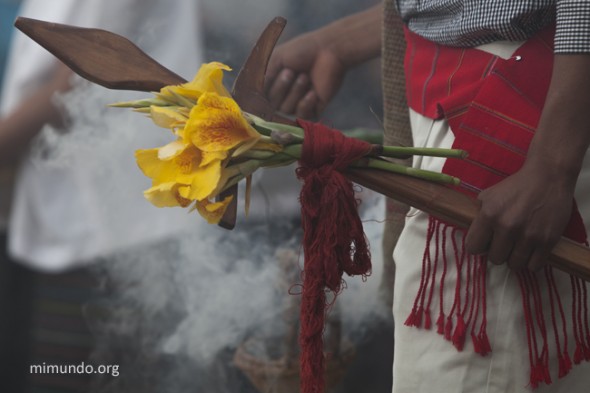
5 thoughts on “2012-12-21. Mayan Oxlajuj Baktun: End of an Era, More of the Same.”
Comments are closed.